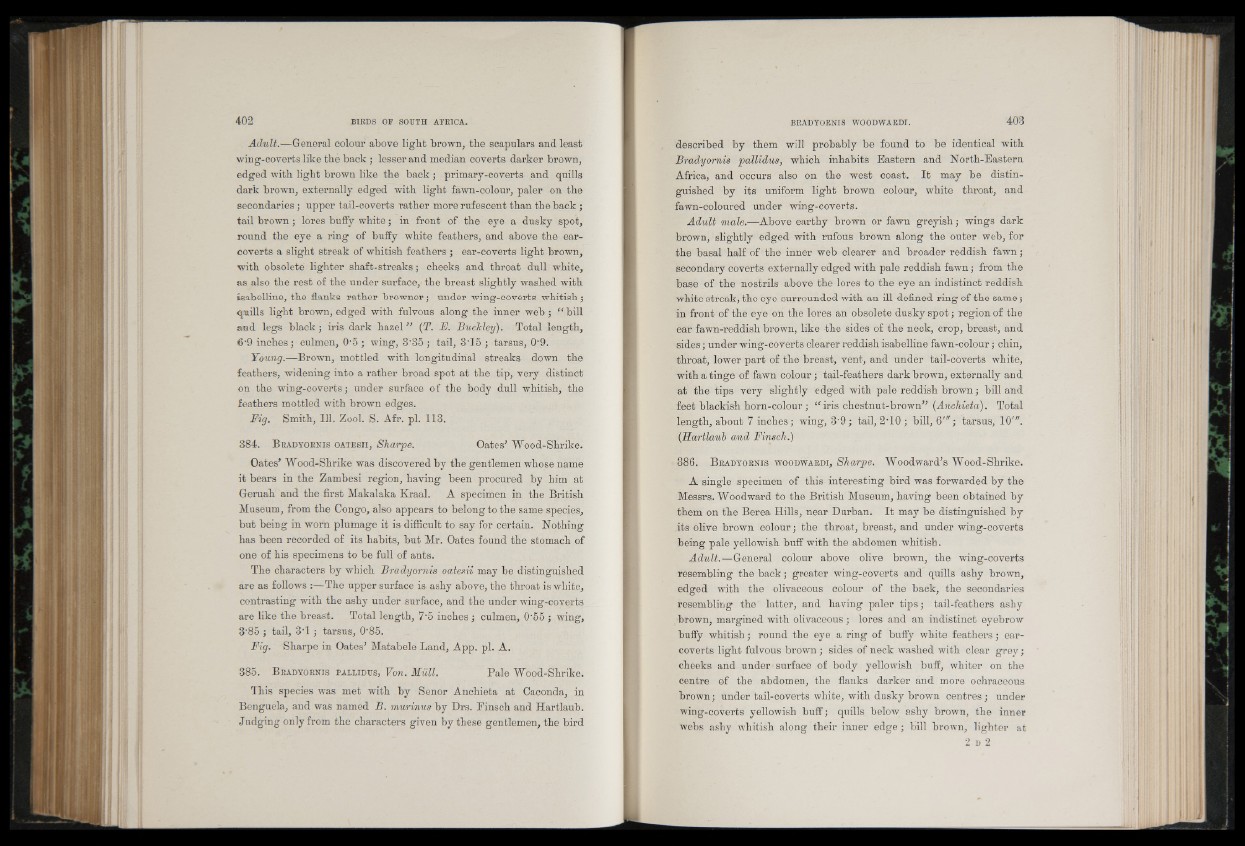
Adult.—General colour above ligbt brown, tbe scapulars and least
wing-coverts like tbe back; lesser and median coverts darker brown,
edged witb ligbt brown like tbe back; primary-coverts and quills
dark brown, externally edged witb ligbt fawn-colour, paler on tbe
secondaries; upper tail-coverts ratber more rufescent tban tbe back ;
tail brown; lores buffy wbite; in front of tbe eye a dusky spot,
round tbe eye a ring of buffy wbite feathers, and above tbe ear-
coverts a slight streak of whitish feathers ; ear-coverts ligbt brown,
witb obsolete lighter shaft-streaks; cheeks and throat dull white,
as also tbe rest of tbe under surface, the breast slightly washed witb
isabelline, tbe flanks ratber browner; under wing-coverts whitish;
quills ligbt brown, edged with fulvous along tbe inner web; “ bill
and legs black; iris dark hazel ” (T. E. Buckley). Total length,
6'9 inches; culmen, 05 ; wing, 3'35 ; tail, 3'15 ; tarsus, 0'9.
Young.—Brown, mottled witb longitudinal streaks down tbe
feathers, widening into a rather broad spot at tbe tip, very distinct
on tbe wing-coverts; under surface of the body dull whitish, tbe
feathers mottled witb brown edges.
Fig. Smith, 111. Zool. S. Afr. pi. 113.
384. B radyornis o a t e s ii, Sharjpe. Oates7 Wood-Shrike.
Oates’ Wood-Shrike was discovered by tbe gentlemen whose name
it bears in tbe Zambesi region, having been procured by him at
Geruah and tbe first Makalaka Kraal. A specimen in tbe British
Museum, from tbe Congo, also appears to belong to tbe same species,
but being in worn plumage it is difficult to say for certain. Nothing
has been recorded of its habits, but Mr. Oates found tbe stomach of
one of his specimens to be full of ants.
The characters by which Bradyornis oatesii may be distinguished
are as follows :—The upper surface is ashy above, the throat is white,
contrasting with the ashy under surface, and the under wing-coverts
are like the breast. Total length, 7‘5 inches ; culmen, 0‘55 ; wing,
3’85 ; tail, 3T ; tarsus, 0’85.
Fig. Sharpe in Oates’ Matabele Land, App. pi. A.
385. B r a d y o r n is p a l l id u s , Von. Mull. Pale Wood-Shrike.
This species was met with by Senor Anchieta at Caconda, in
Benguela, and was named B. mu/rinus by Drs. Pinsch and Hartlaub.
Judging only from the characters given by these gentlemen, the bird
described by them will probably be found to be identical with
Bradyornis pallidus, which inhabits Eastern and North-Eastern
Africa, and occurs also on the west coast. It may be distinguished
by its uniform light brown colour, white throat, and
fawn-coloured under wing-coverts.
Adult male.—Above earthy brown or fawn greyish; wings dark
brown, slightly edged with rufous brown along the outer web, for
the basal half of the inner web clearer and broader reddish fawn;
secondary coverts externally edged with pale reddish fawn; from the
base of the nostrils above the lores to the eye an indistinct reddish
white streak, the eye surrounded with an ill-defined ring of the same;
in front of the eye on the lores an obsolete dusky spot; region of the
ear fawn-reddish brown, like the sides of the neck, crop, breast, and
sides; under wing-coverts clearer reddish isabelline fawn-colour; chin,
throat, lower part of the breast, vent, and under tail-coverts white,
with a tinge of fawn colour; tail-feathers dark brown, externally and
at the tips very slightly edged with pale reddish brown; bill and
feet blackish horn-colour; “ iris chestnut-brown” (Anchieta). Total
length, about 7 inches; wing, 3'9; tail, 2TO ; bill, 6'"; tarsus, 10'".
(Hartlaub a/nd Finsch.)
386. B r a d y o r n i s w o o d w a r d i , Sharpe. Woodward’s Wood-Shrike.
A single specimen of this interesting bird was forwarded by the
Messrs. Woodward to the British Museum, having been obtained by
them on the Berea Hills, near Durban. It may be distinguished by
its olive brown colour; the throat, breast, and under wing-coverts
being pale yellowish buff with the abdomen whitish.
Adult.—General colour above olive brown, the wing-coverts
resembling the back; greater wing-coverts and quills ashy brown,
edged with the olivaceous colour of the back, the secondaries
resembling the latter, and having paler tips; tail-feathers ashy
brown, margined with olivaceous; lores and an indistinct eyebrow
buffy whitish; round the eye a ring of buffy white feathers; ear-
coverts light fulvous brown ; sides of neck washed with clear grey;
cheeks and under surface of body yellowish buff, whiter on the
centre of the abdomen, the flanks darker and more ochraceous
brown; under tail-coverts white, with dusky brown centres; under
wing-coverts yellowish buff; quills below ashy brown, the inner
webs ashy whitish along their inner edge; bill brown, lighter at